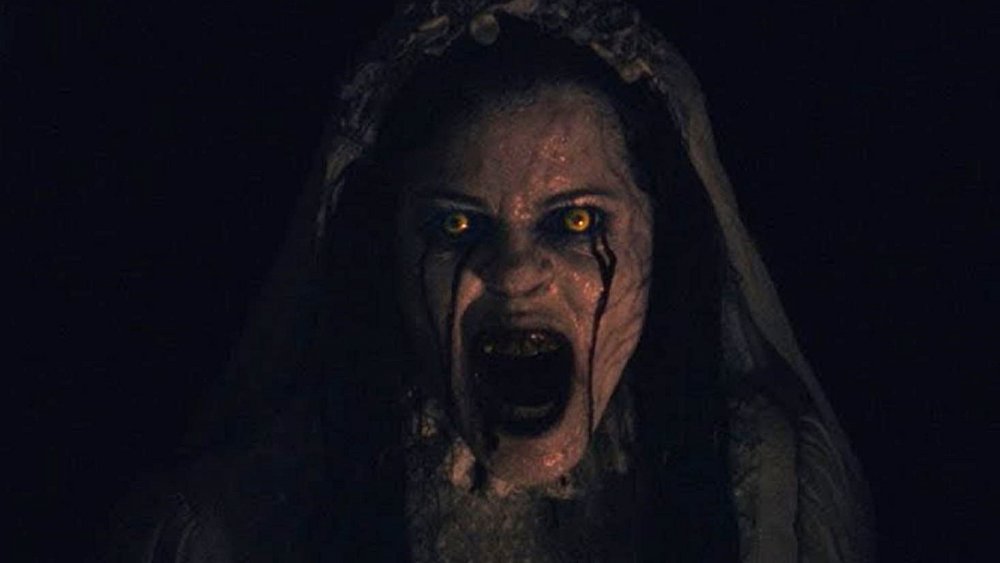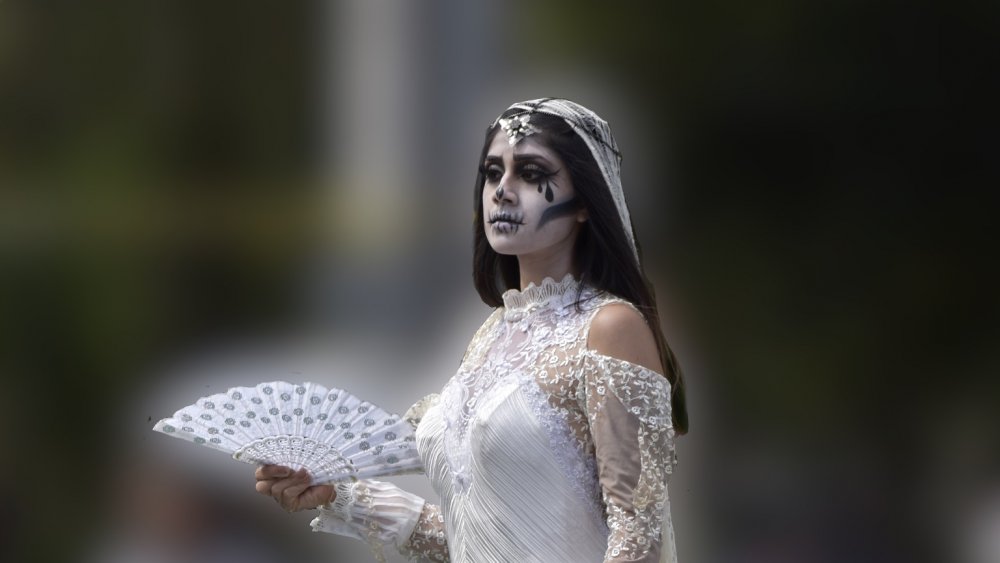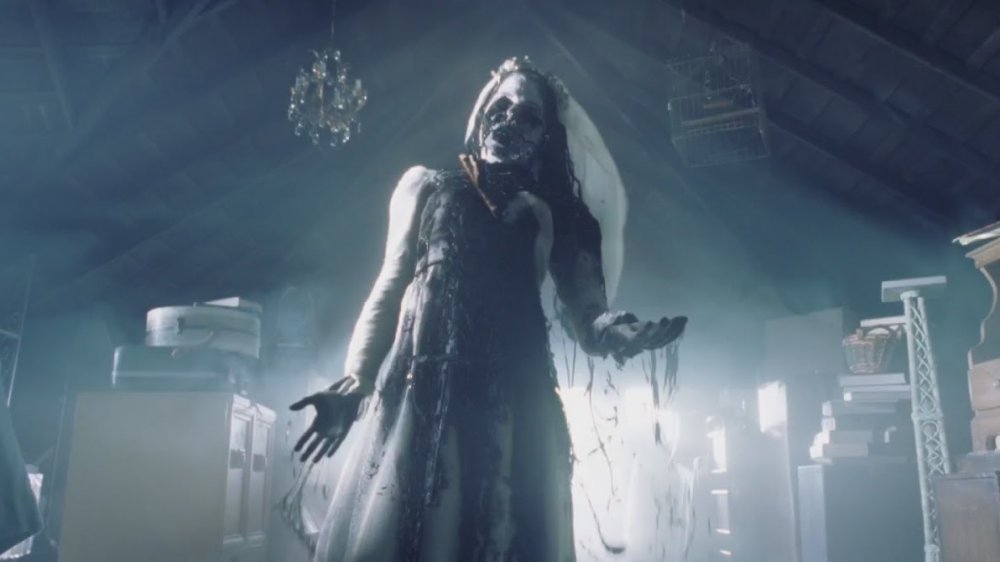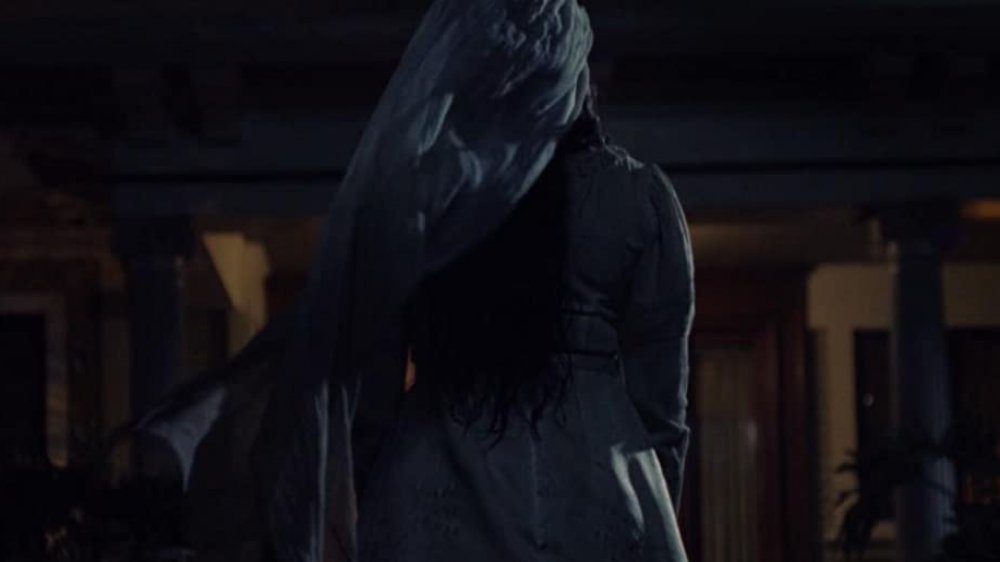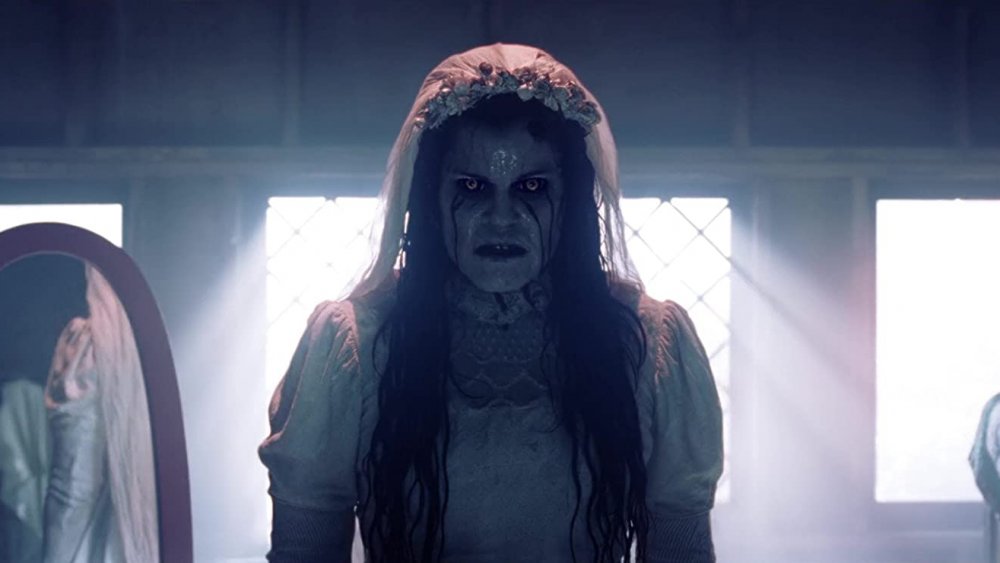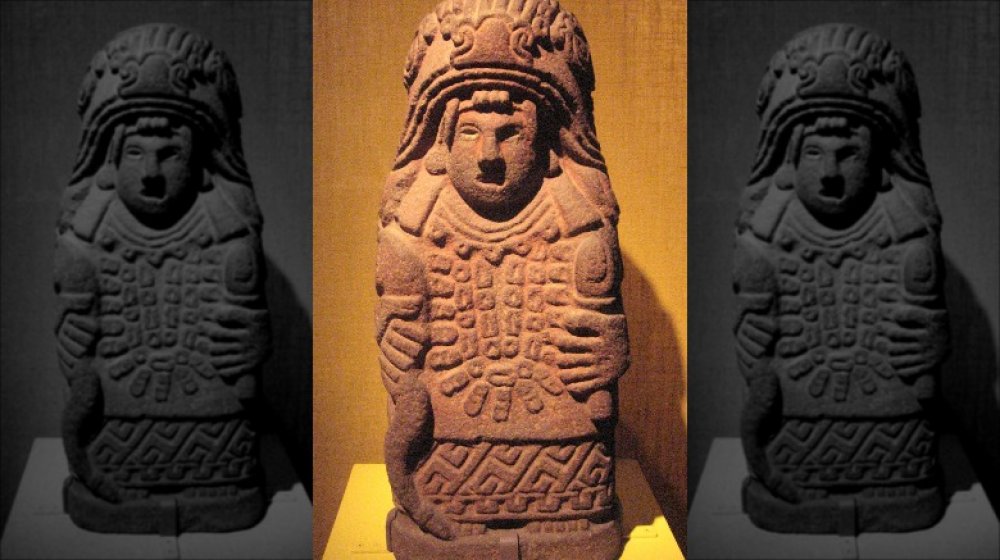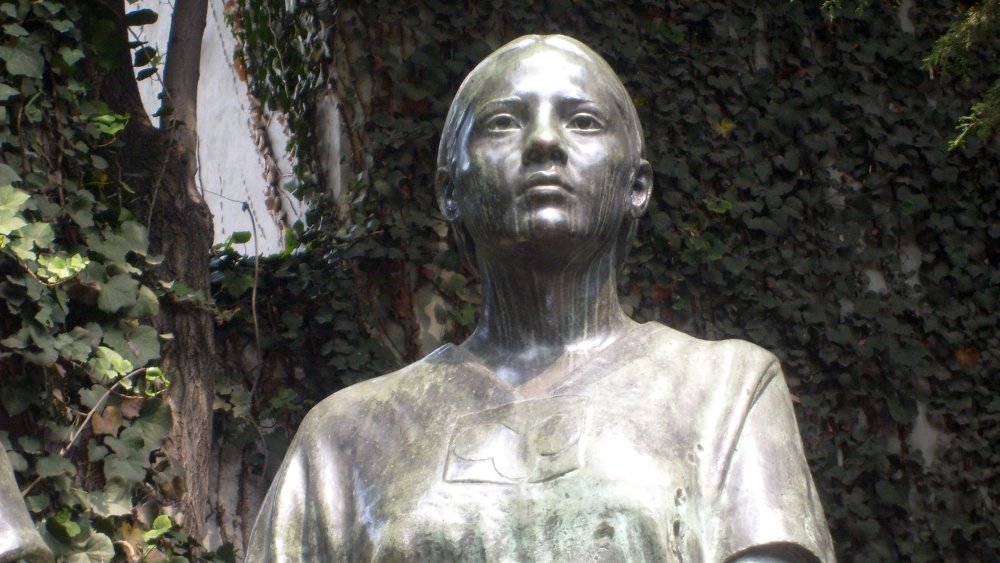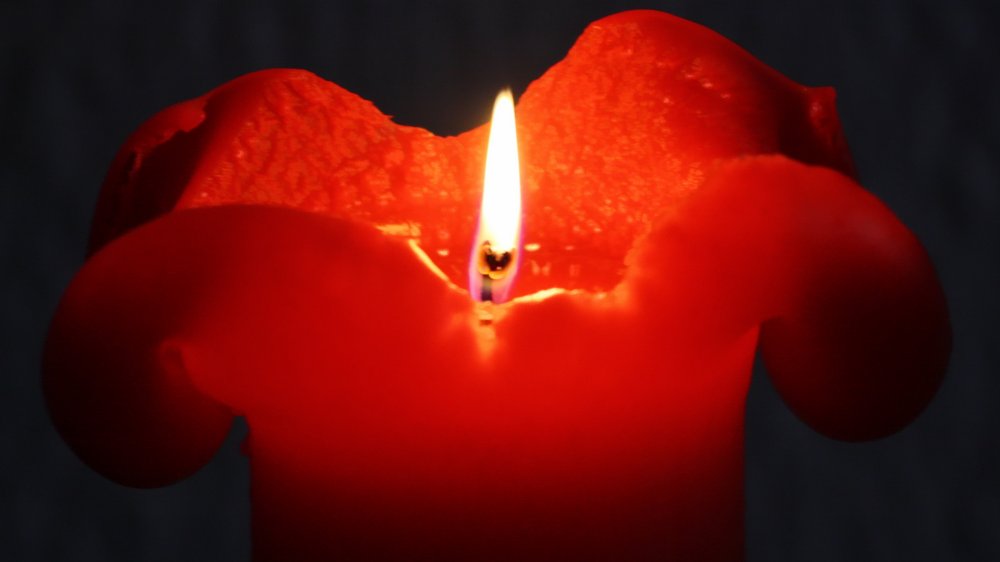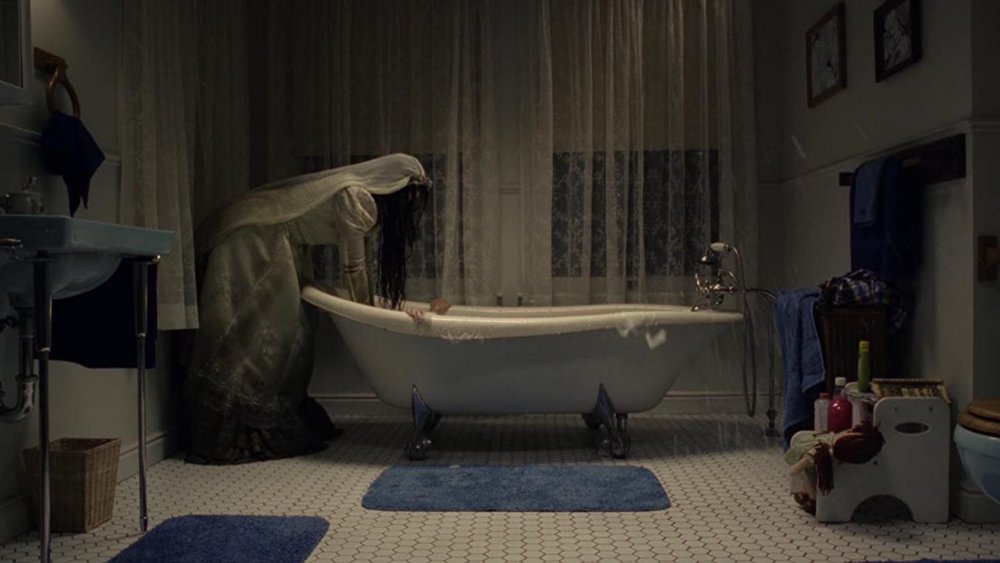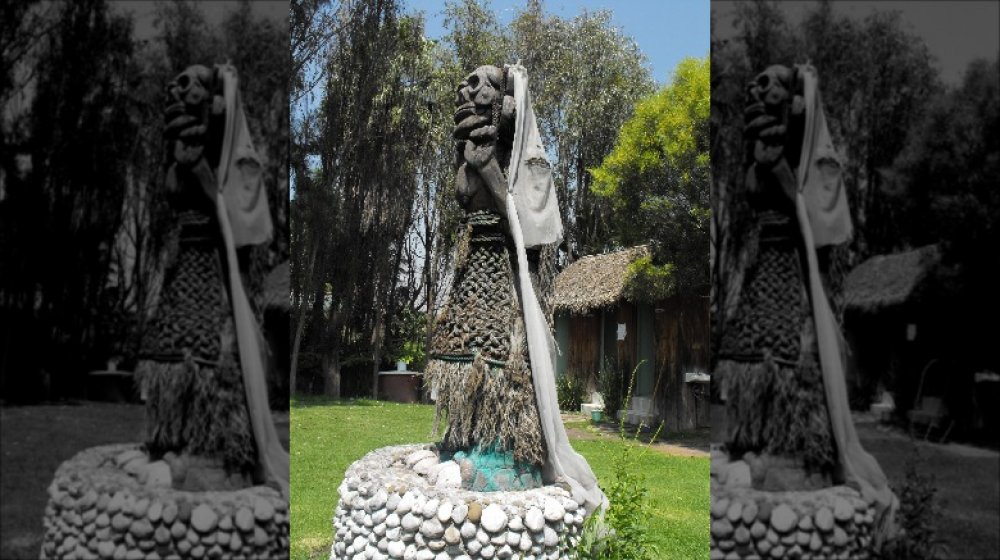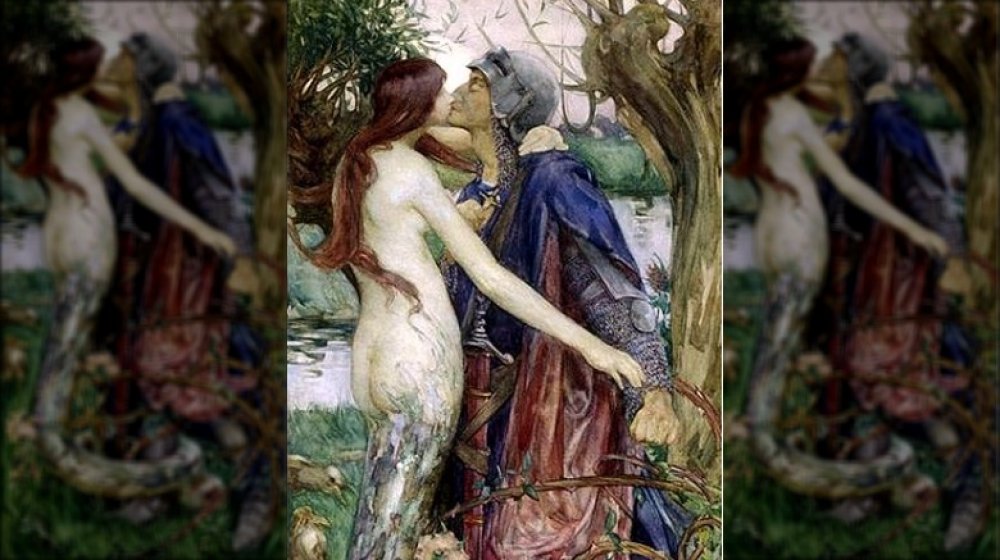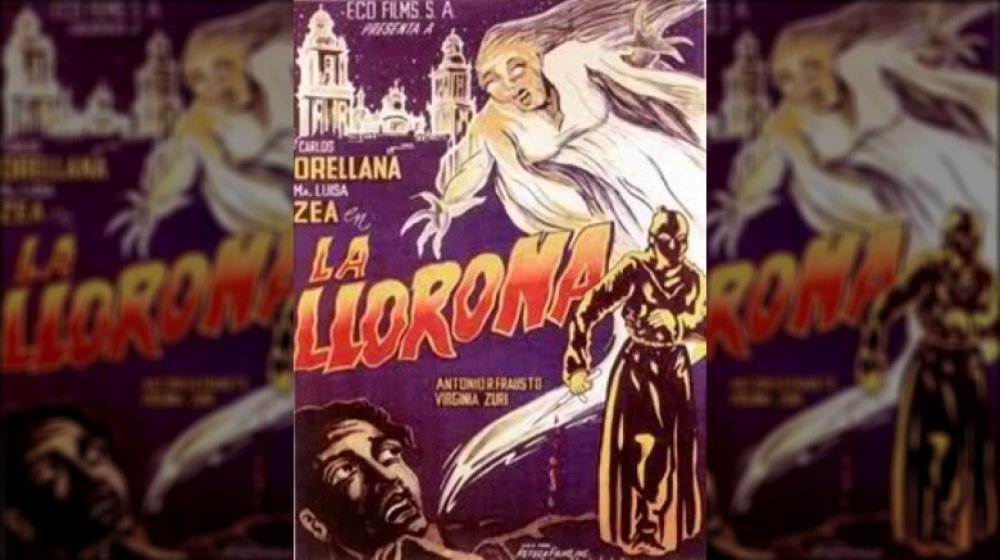The Legend Of La Llorona Explained
Every culture has its famous ghosts, and the most famous ghost of Latin America is undoubtedly La Llorona, the crying woman. This spectral apparition is known to children all the way from Texas and New Mexico down through Mexico and Guatemala, and all the way to the tip of South America. Her eerie cries foretell death and danger for naughty children, or maybe unfaithful husbands, as her weeping echoes over various bodies of water and threatens an impending drowning.
The story of La Llorona is becoming better known in the United States thanks to supernatural television shows and horror movies like 2019's The Curse of La Llorona, but what do you really know about the wailing woman? Read on to learn all about her origins and modern day sightings, but be sure to obey your mom and listen out for spooky sobbing over the water.
Who is La Llorona?
La Llorona is arguably the best known spookum in Latin America, and generations of children in Mexico and Central and South America have been terrified of this deadly apparition. As Vanity Fair explains, La Llorona is the wailing ghost of a woman whose spirit roams the earth due to the sins she committed in her life; namely, the drowning of her own children. The name "La Llorona" means "the weeping woman" (from the Spanish verb llorar, meaning "to weep"), and that's exactly what she is: a looming specter who can almost always be heard before she is seen. Legend says that her spirit can be found hovering over and near bodies of water in her long white gown, crying for her lost children and at her own crime. Some versions of the story say she hunts down children to kidnap or attack, while others say she is on the lookout to lay some supernatural vengeance on unfaithful husbands.
For many Latinx children, La Llorona is a story constantly told from child to child or from parents to misbehaving children. Actress Patricia Velasques (who appeared in 2019's Curse of La Llorona) told Bustle that La Llorona is very real to Latinx children and a common threat by parents to get their kids to do what they want: for example, "Make sure you have to come in at 5, otherwise La Llorona is gonna come and get you."
The legend behind the legend
Many ghost legends have a tragic story to go along with them, but they're not always as well known as the ghost itself. Consider how many American kids know Bloody Mary but don't know anything about her background. La Llorona, on the other hand, has a couple of popular stories that might explain the crying ghost who wants to drown your children. Legends of America tells what is probably the most-repeated version of the story: in life La Llorona was named Maria, a poor but beautiful woman who caught the eye of a rich man who showered her with affection (in many versions of the story, Maria is an indigenous woman while the man is Spanish). Soon she bore the man two sons, at which point the man's attitude began to change.
He soon ignored Maria, turning his attention to chasing women and booze. When he would come to visit the young woman, he would only spend time with the children, and he would talk about marrying a woman more suited to his class and lifestyle. Soon Maria resented the attention that the boys got from their father that she desired, and in a fit of rage at seeing her lover with his new wife, drowned her children in the river. Realizing what she had done, she wasted away with grief and wailing until all that was left was a weeping specter on the riverbank.
A second, different legend behind the legend
Most of the variations on the origin of La Llorona are consistent on the basic idea that the weeping woman was once a human lady named Maria who was doomed to wander the earth as a ghost seeking fruitlessly for the souls of her children after she drowned them, which is why she is said to kidnap living children; she has mistaken them for her own. Legends of America records a version of the story in which Maria was a young but beautiful peasant woman who captured the attention of men both rich and poor when she would go out at night in her best white gown to dance. However, she was already at this point feeling burdened by two young sons that made it difficult for her to spend all of her time among the men who lavished such attention on her. In this version of the story, it was through Maria's neglect while spending her nights out dancing that her two sons were subsequently found drowned in the river, though rumors abounded that they died by their own mother's hand, as she wanted to be divested of her burdensome children.
In some versions of the story, Maria is told she will not be granted entrance to Heaven until she finds the souls of her children, either by God himself or by a demon trying to trick her, as the boys' souls are already in Heaven.
Poetic origins of La Llorona
While there are those who contend that the origins of La Llorona stretch back centuries, to the era of conquistadors or even earlier, the indisputably earliest written account of La Llorona dates back to 1883, in a sonnet written by poet Manuel Carpio. Carpio was a Mexican poet, theologian, and philosopher who lived from the late 18th to mid-19th century and who was a member of the literary movement known as Mexican Romanticism. The version of the wailing woman presented in his poem, however, differs significantly from the popular oral legend told today. For example, the infanticide at the center of the modern ghost legend is completely absent from the original text, which tells instead of a woman who was murdered by her husband.
In the version found in the poem, the weeping woman's name was Rosalia, not Maria, and all we know of her life from the 14-line poem is that she lived in the narrator's village and was killed by her criminal husband. "Ever since," the sonnet says, "the frightened people, trembling in the gloomy night, hear the sad groans of the grieving woman." This shrieking apparition wanders the streets and riverbank, filling all who hear her voice with deadly horror. "And by the river," the poem concludes, "in the thick darkness, she leaves crying, wrapped in her cloak."
Mythological origins of La Llorona
While the folkloric origins of the figure of La Llorona are shrouded in obscurity, there is some evidence that the story might include elements of Aztec mythology in its roots. According to History Today, the figure of La Llorona shares some DNA with some Aztec goddesses who were said to have been omens of the conquest of Mexico by Hernan Cortes. The first of these, Ciuacoatl ("snake-woman"), is described in the Florentine Codex, a 16th century work by a Franciscan monk cataloging the culture of the Nahua peoples of Mexico, as a "savage beast and an evil omen" dressed in white who prowled the land at night "weeping and wailing." A later codex describes Coatlicue, who is identified with Ciuacoatl, as a goddess who weeps while waiting for her child to return from war. Both codices describe a woman wailing in the streets for her lost children as an omen of war and conquest.
The Florentine Codex goes on to tell of the goddess Chalchiuhtlicue ("the jade-skirted one"), who was a widely feared goddess of the waters. She was known to overturn boats and drown the sailors within. According to the codex, children were sacrificed to Chalchiuhtlicue, and the more they cried, the more the goddess was propitiated. While it's not completely clear that La Llorona is a true descendant of these figures, the presence of wailing women, drowning, and infanticide is somewhat compelling.
Historical origins of La Llorona
Some students of the La Llorona legend believe that the modern ghost story has its roots not in mythology, but in history. As History Today points out, there are those who see a significant similarity between the story of the wailing woman and Hernan Cortes' interpreter and concubine, known as La Malinche. The legend surrounding La Malinche is that she was an indigenous woman who was betrayed by her Spanish lover to marry a Spanish woman and that her wounded pride led her to murder the child she bore him. While all those elements are echoed in the popular version of the La Llorona legend, there is no evidence that these things really happened. Rather, this story seems to be an attempt to create a microcosm for the heartless way Europeans dealt with the indigenous culture.
According to JSTOR Daily, the real La Malinche, known also as Doña Marina and Malintzin, was the daughter of an Aztec chief who was sold as a slave after her father's death, ultimately landing in Cortes's possession. From there, she acted as his interpreter and guide as well as mistress, but there is little evidence that there was much of the fiery, even murderous, emotion to their relationship that the legend would seem to indicate. Scholars claim that "there is no indication that their relationship involved love or even enthusiasm."
How to summon the Wailing Woman
Some people just can't leave well enough alone. If you tell them the process for summoning a ghost or demon who will definitely kill them if that process is followed, those people will still absolutely follow that process if they get bored enough at a sleepover. Don't say the thing into the mirror, kids. Don't go into the dark bathroom with your friends and say the thing. Why would you do it? That's how you get Bloody Marys (not the fun kind) and/or Candymans. There are so many other cool things to do at a party, like reading informative articles about the history of popular Latinx ghosts on the internet.
But let's say you are at a sleepover and you just have to see a ghost and you've already summoned Bloody Mary and/or Candyman, and you're wanting to expand your horizons vis-a-vis the various cultures whose murderous mirror ghosts you might summon. Don Quijote instructs that in Mexico those who want to summon La Llorona can do so by going into a room whose walls are lined with mirrors, closing the door, and lighting red candles all over. As you might guess, you then repeat her name until you hear her wailing "Ay, mis hijos!" ("Oh, my children!") and hope that there's nothing in the room she can drown you in. Otherwise, presumably the best way to see her is to be a misbehaving child.
Modern sightings of the Weeping Woman
As La Llorona is one of the most popular ghost legends throughout pretty much every Spanish-speaking country in the Western Hemisphere, it should be no surprise that there is an abundance of modern-day sightings of the weeping apparition. Legends of America records a number of different encounters, including a man who claims that as a boy he and his family saw a woman floating over the water of a creek in New Mexico, who turned toward a hill and then vanished. He describes the woman as tall and thin and says that when he went over to where she had been, there were no footprints.
Another story reports that young brothers had run away from their ranch home in New Mexico in a wagon after a heated argument with their parents. As they made their way toward Santa Fe, a woman dressed in black and whose face was covered with a veil suddenly appeared between the two boys sitting in the front of the wagon. She sat silently between them until the boys turned the horses back toward home, at which point she assured them they would see her again if they ever argued with their mother. Likewise, in Santa Fe there have been numerous sightings of a weeping ghost in the Public Employees Retirement Association Building, which is said to be on the former site of a Spanish-Indian graveyard.
A real-life La Llorona
While the story of La Llorona, a ghost seeking to drown bad children, is only a legend, at least one incident inspired by the story is tragically all too real. Syfy Wire relates the account of the 1986 case of Juana Léija, a Texas mother who, believing herself to be an incarnation of La Llorona, attempted to drown six of her seven children by throwing them into the bayou. Fortunately, most of the children survived, but two of them died as a result of their mother's episode.
The New York Times explains that Léija plead no contest to the charges of murder against her, but was found to have been mentally unsound at the time of her actions. Léija was in an abusive marriage, and she came to believe that she was saving her children from an evil world by drowning them. The Houston Chronicle further relates that she had been badly beaten by her husband the night before and had not eaten in days and had started to hear voices. She later learned that she was suffering from bipolar disorder, seemingly compounded by postpartum depression after the birth of her sixth child. Léija was sentenced to 10 years' probation and received the help she needed. She was divorced from her abusive husband after her trial and remarried. Unfortunately, stories like Léija's where a mother kills her children thinking she is protecting them are not uncommon.
Similar figures from world mythology
As modern Latin American culture is a blend of the indigenous peoples and Spanish conquerors who colonized the area, it makes some amount of sense that the most famous ghost legend in that modern culture would reflect elements of the cultures that comprise it. Besides the various Aztec myths that seem to share some aspects with the modern La Llorona, there are a number of European legends that bear some similarities to the wailing woman as well. Notably, the Greek myth of Lamia tells of a queen who was loved and betrayed by Zeus, after which she became a night-prowling monster who ate children. The Jewish legend of Lilith, Adam's first wife who was expelled from Eden and became a mother of demons, contains some of that same DNA as well.
But besides the revenge infanticide, La Llorona is part of a much wider tendency in ghost legend around the world, the figure of the Woman in White. As Gizmodo explains, stories about ghostly women in white dresses are basically ubiquitous, from Germany and the Netherlands to tales of the yurei in Japan. And of course, La Llorona's trademark crying, which is sometimes said to be an omen of death, bears more than a passing resemblance to the banshee, the fairy woman of Irish lore, whose eerie wailing is said to foretell the impending death of a family member.
Mexico's first horror film
La Llorona has been a star of the big screen for basically as long as they've been making horror movies. In fact, the very first horror movie filmed in Mexico, as well as Mexico's all-sound film, was 1933's La Llorona, known in English as The Crying Woman. The film, directed by Cuban director and screenwriter Ramon Peon and starring Ramon Pereda and Virginia Zuri as the couple haunted by the titular crying woman, followed on the heels of successful American horror films such as 1931's Frankenstein and Dracula (and the Spanish-language version of Dracula as well) and led to a string of classic Mexican horror films including Dos Monjes and El Fantasma del Convento, both from 1934.
La Llorona is set in modern-day (well, modern for 1933) Mexico and shows a spectral woman lurking through an upper-class family's home and attempting to sacrifice the couple's son on a pagan altar. From there, two different flashback sequences lay out two possible origins of La Llorona: both the version of Maria, abandoned by her lover and killing their illegitimate child in revenge, and the story of La Malinche, going mad after her baby is taken away from her by the Spanish authorities. The story of the wailing woman was told again in the 1960 Mexican production of La Llorona, which features a different modern story to frame the legend.
La Llorona, movie star
The classic story of La Llorona has not been merely relegated to classic horror films, however. The hugely popular ghost tale has continued to serve as fuel for filmmakers' imaginations well into the current day. For example, 2013's Mama, from Mexican producer Guillermo del Toro and Argentinian writer/director Andy Muschietti, reimagines the story of La Llorona with Jessica Chastain and Nikolaj Coster-Waldau as a couple who suddenly find themselves haunted by a ghostly mother figure after they are forced to adopt their tragically orphaned nieces. The 2007 independent horror film The Cry is a more straightforward version of the La Llorona story about a police detective investigating missing children.
The highest profile adaptation of the legend, however, is undoubtedly 2019's The Curse of La Llorona, starring Linda Cardellini as a social worker trying to protect her own children from the wailing woman, which turned out to secretly be part of The Conjuring series of films. It was ... fine. The year 2019 also saw the release of a much better La Llorona film, called, well, La Llorona, a Guatemalan production that uses the famous legend to examine the history of genocidal crimes against indigenous people in Latin America. It manages to be a supernatural revenge picture that also puts a lens on a serious issue in a way that might even make the weeping woman smile.
